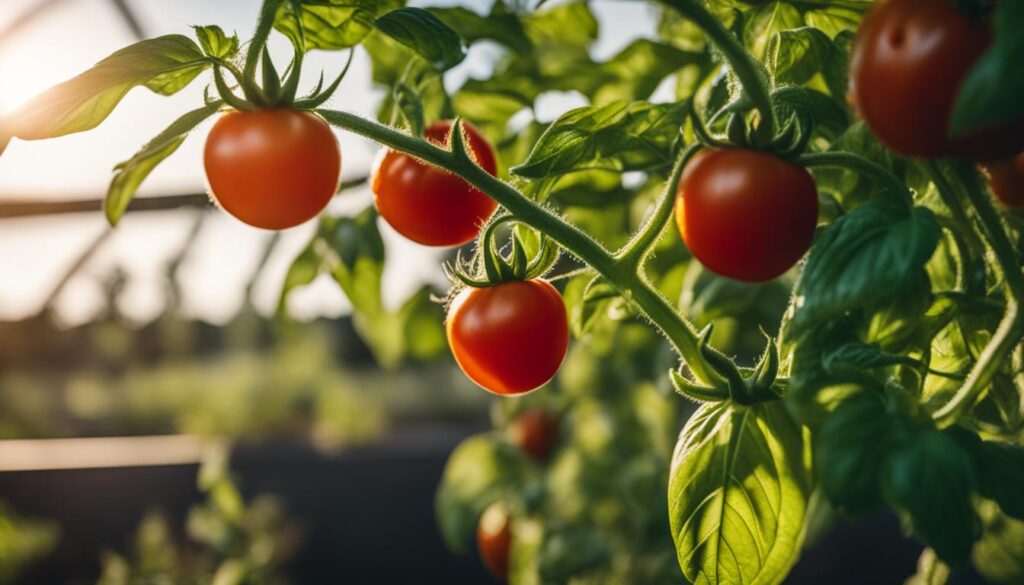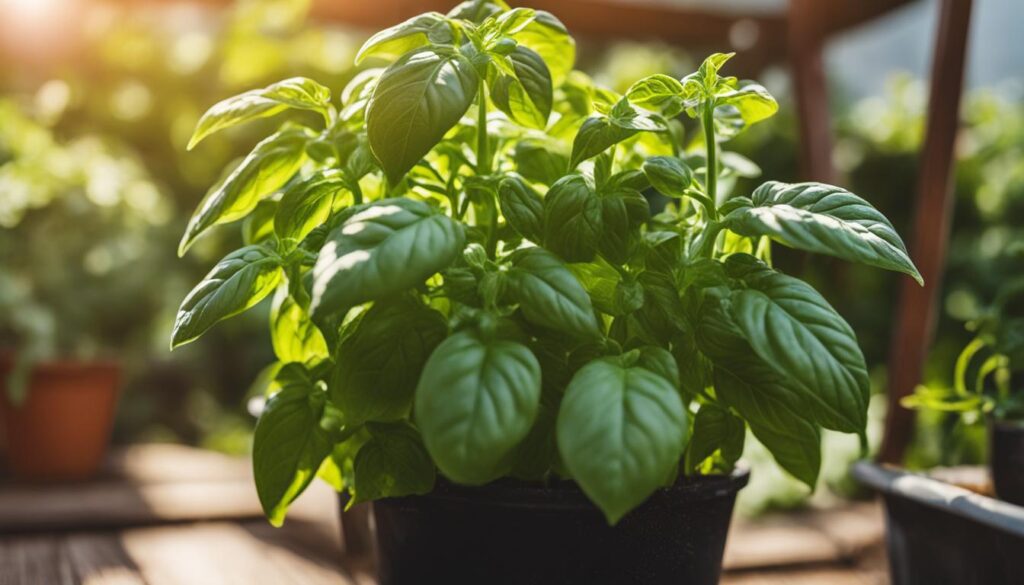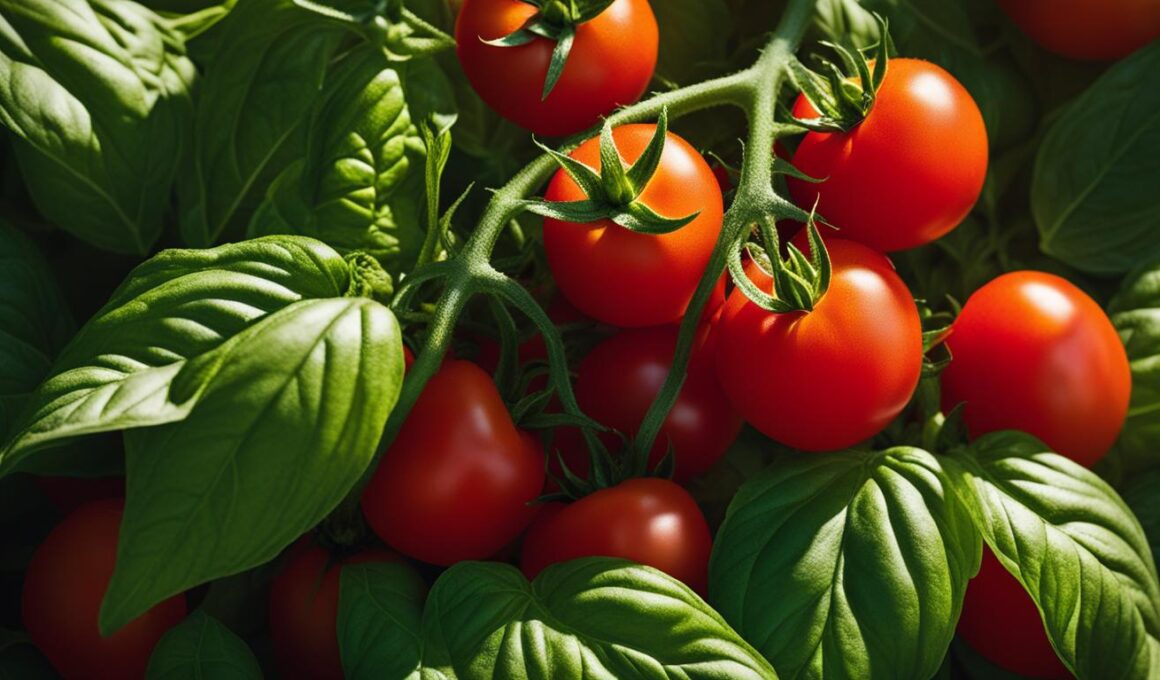Growing basil and tomatoes together not only creates a delightful culinary combination but also offers numerous benefits in the garden. Companion planting is the practice of planting certain crops together to enhance their growth and protect them from pests. Basil and tomatoes, when planted near each other, create a symbiotic relationship that promotes healthy plants and increased fruit production. If you’re interested in learning how to successfully grow basil and tomatoes together, here are some essential tips and techniques to get you started.
Post Summary:- Companion planting basil and tomatoes provides mutual benefits in the garden.
- Basil acts as a natural pest repellent for tomatoes, protecting them from whiteflies, aphids, and thrips.
- Tomatoes provide shade and soil moisture conservation for basil.
- Both basil and tomatoes have similar growing requirements, making them ideal for planting together.
- Growing basil and tomatoes together enhances the flavor of tomatoes and increases fruit production.
The Benefits of Companion Planting
Companion planting offers a range of benefits for your garden. By strategically planting certain crops together, you can promote pest control, provide support, improve soil quality, and offer shelter for your plants. These benefits not only enhance the health and productivity of your garden but also reduce the need for chemical pesticides and fertilizers.
Pest Control
One of the significant advantages of companion planting is natural pest control. Some plants, such as basil, have natural properties that repel pests. By interplanting these pest-repellent plants alongside vulnerable crops, you can create a barrier that deters harmful insects and pests. This can help protect your plants from damage and disease, reducing the need for chemical interventions.
Support and Soil Quality
Companion planting also allows for plants to support and benefit each other in terms of growth and soil health. Tall plants, like tomatoes, can provide shade and shelter for smaller, more delicate plants such as basil. This shade helps prevent excessive sun exposure and can conserve moisture in the soil, creating a more favorable environment for companion plants.
In terms of soil quality, certain companion plants have the ability to add nutrients to the soil. For example, legumes like peas and beans can fix nitrogen in the soil, enriching it for neighboring plants. This mutual support can result in healthier plants with improved growth and productivity.
Shelter
Companion planting can also provide shelter for plants that are more vulnerable to wind and harsh sunlight. Taller crops, such as corn or sunflowers, can act as natural windbreaks, protecting smaller plants from strong gusts that can cause damage or stunting. Additionally, the shade provided by taller plants can help reduce moisture loss and prevent excessive evaporation, creating a more stable microclimate for companion plants.
| Companion Plant | Benefit |
|---|---|
| Basil | Natural pest repellent |
| Tomatoes | Shade and moisture conservation |
| Peas and beans | Nitrogen fixation for soil enrichment |
| Corn and sunflowers | Windbreak and shade |
By harnessing the benefits of companion planting, you can create a balanced and thriving garden ecosystem. Whether it’s repelling pests, providing support, improving soil quality, or offering shelter, companion planting is a sustainable and effective way to enhance the health and productivity of your plants.
The Symbiotic Relationship Between Basil and Tomatoes
Basil and tomatoes have a special symbiotic relationship in the garden, benefiting each other in multiple ways. When planted together, these two plants form a harmonious partnership that enhances their growth and overall health.
One of the key benefits of this symbiotic relationship is pest control. Basil acts as a natural repellent for pests that can harm tomatoes, such as whiteflies, aphids, and thrips. By planting basil near tomatoes, you can help protect your tomato plants from these common pests, reducing the need for chemical pesticides.
Additionally, basil serves as an early warning system for potential diseases in tomatoes. It is known to be susceptible to certain diseases before tomatoes show any symptoms. By keeping a close eye on the health of your basil plants, you can take preventive measures to protect your tomatoes from these diseases, ensuring their continued growth and productivity.
To further strengthen their symbiotic relationship, tomatoes provide shade and conserve moisture for basil. Basil plants prefer consistent moisture in the soil and can benefit from the shade provided by taller tomato plants. This shade helps to regulate moisture levels, preventing the basil plants from drying out and maintaining optimal growing conditions.
Overall, the partnership between basil and tomatoes results in healthier plants and increased fruit production. They support each other’s growth and well-being, creating a thriving garden ecosystem.
The Mutual Benefits of Basil and Tomatoes
| Basil | Tomatoes |
|---|---|
| Acts as a natural pest repellent | Provides shade for basil plants |
| Serves as an early warning system for diseases | Helps conserve moisture for basil plants |
| Enhances flavor of tomatoes | Supports healthier growth of basil |
| Increases fruit production | Creates a thriving garden ecosystem |
Planting Basil and Tomatoes Together
Planting basil and tomatoes together is a simple and rewarding gardening technique. These two plants are not only a delicious culinary combination but also have a beneficial relationship in the garden. To successfully grow basil and tomatoes together, follow these garden tips and techniques:
Planting Requirements
Basil and tomatoes thrive in full sun and well-drained soil. Choose a location in your garden that receives at least 6-8 hours of direct sunlight each day. Prepare the soil by removing any weeds or debris and ensuring it is well-draining. If you’re planting in containers, use a high-quality potting mix that provides good drainage.
Companion Planting
When planting basil and tomatoes together, it’s best to have one basil plant per tomato plant. You can either plant basil around the base of the tomato plant or sow basil seeds alongside tomato starts. To ensure proper spacing, sow 4-5 basil seeds around each tomato plant and thin them out once they reach a few inches tall. This will prevent overcrowding and allow both plants to grow and develop properly.
Container Planting
If you’re limited on space or prefer container gardening, basil and tomatoes can also be grown in pots. Place the basil pot next to the tomato pot to maximize the benefits of companion planting. Remember to provide adequate space for both plants to grow and thrive. To prevent nutrient competition, have one basil plant per container. Thin out basil seedlings if growing them together in a single container.
| Planting Tips | Garden Techniques |
|---|---|
| Choose a sunny location | Plant basil around tomato base |
| Ensure well-drained soil | Sow basil seeds alongside tomato starts |
| One basil plant per tomato plant | Thin out basil seedlings for proper spacing |
| Provide sufficient space in containers | Place basil pot next to tomato pot |
By following these planting tips and techniques, you’ll be able to enjoy the benefits of growing basil and tomatoes together. Whether in your garden or containers, this companion planting duo will not only provide you with a bountiful harvest but also enhance the flavors of your culinary creations. Get ready to savor the delightful combination of fresh basil and juicy tomatoes!

Growing Basil and Tomatoes in Containers
Growing basil and tomatoes in containers is a convenient and space-saving option for gardeners who may have limited outdoor space or prefer to have their plants within easy reach. Container gardening allows you to enjoy the benefits of companion planting and cultivate fresh herbs and vegetables right outside your doorstep. Here are some tips to help you successfully grow basil and tomatoes in pots.
If you choose to plant basil and tomatoes in separate pots, it is recommended to place the basil container next to the tomato container. This arrangement allows the plants to benefit from each other’s presence and provides an ideal setup for companion planting. Ensure that both containers are large enough to accommodate the mature size of each plant, as basil and tomato roots need space to develop.
When planting basil and tomatoes together in a single container, it is crucial to prevent nutrient competition. To achieve this, it is best to have one basil plant per container. This ensures that both plants receive an adequate supply of nutrients and water. Additionally, it is important to thin out the basil seedlings to avoid overcrowding and promote proper growth.
| Basil Container: | 12-inch diameter pot |
|---|---|
| Tomato Container: | 18-inch diameter pot |
| Number of Basil Plants: | 1 per container |
“Container gardening allows you to enjoy the benefits of companion planting and cultivate fresh herbs and vegetables right outside your doorstep.”
Both basil and tomatoes thrive in well-draining soil and require at least six hours of direct sunlight each day. Ensure that your containers have drainage holes to prevent waterlogging, and use a high-quality potting mix specifically formulated for container gardening. Regularly monitor the soil moisture levels and water the plants when the top inch of soil feels dry to the touch.
Remember to provide support for tomato plants as they grow taller. You can use stakes or tomato cages to help maintain their upright growth and prevent fruit-bending or breakage. Regularly pinch back the basil plants to encourage bushier growth and ensure a continuous supply of fresh leaves.

Maximizing Space with Vertical Gardening
If you have limited floor space, consider vertical gardening techniques to grow basil and tomatoes in containers. You can use trellises or vertical planters to maximize your available space and create a visually appealing garden display. This approach not only saves space but also allows you to grow more plants in a smaller area.
Remember to provide adequate support for both the basil and tomato plants when using vertical gardening methods. As the tomato plants climb, tie them to the trellis or vertical planter to ensure stability and prevent damage.
By following these container gardening techniques, you can enjoy the benefits of growing basil and tomatoes together, even in limited spaces. Not only will you have a beautiful and productive garden, but you’ll also have fresh ingredients at your fingertips for culinary delights!
Enjoying the Benefits of Basil and Tomatoes
Planting basil and tomatoes together not only brings benefits to your garden but also offers a world of culinary delights. The flavorful combination of basil and tomatoes can be enjoyed in various recipes, adding a fresh and vibrant touch to your meals. Let’s explore some mouthwatering basil and tomato recipes that showcase the results of companion planting.
1. Caprese Salad: This classic Italian dish celebrates the harmonious pairing of basil and tomatoes. Layer slices of ripe tomatoes with fresh basil leaves, mozzarella cheese, and drizzle with olive oil and balsamic vinegar for a refreshing and light salad.
2. Tomato Basil Pasta: Bring together the flavors of basil and tomatoes in a comforting pasta dish. Cook your favorite pasta and toss it with a homemade tomato sauce infused with chopped basil leaves. Finish with a sprinkle of Parmesan cheese for added richness.
“The combination of basil and tomatoes creates a symphony of flavors that is hard to resist. Whether in a simple salad or a hearty pasta dish, the fresh and aromatic notes of basil enhance the natural sweetness of tomatoes.”
3. Basil Tomato Bruschetta: Elevate your appetizer game with this classic Italian bruschetta. Toast slices of baguette and top them with a mixture of diced tomatoes, basil, garlic, and olive oil. The vibrant colors and flavors make it a perfect starter for any meal.
4. Basil Tomato Pizza: Create a homemade pizza bursting with the flavors of basil and tomatoes. Spread tomato sauce on a pizza crust and layer it with mozzarella cheese, sliced tomatoes, and fresh basil leaves. Bake until the crust is crispy and the cheese is melted for a delicious homemade pizza.
By incorporating these basil and tomato recipes into your culinary repertoire, you can fully enjoy the results of companion planting while delighting your taste buds. Explore the versatility of this dynamic duo and discover new ways to savor the flavors of basil and tomatoes.
Can I Grow Basil and Bell Peppers Together in the Same Garden?
Yes, you can definitely grow basil and bell peppers together in the same garden. These two plants make great companions due to their compatible needs and beneficial effects. Basil acts as a natural pest repellent for bell peppers while also enhancing their flavor. So, feel free to plant them side by side and enjoy a flourishing and flavorful garden.
Conclusion
Congrats on discovering the benefits of growing basil and tomatoes together! These two plants make perfect garden companions, providing each other with pest control, shade, and moisture conservation. By planting them side by side, you can create a symbiotic relationship that leads to healthier plants and increased fruit production.
Not only do basil and tomatoes thrive together in the garden, but they also create culinary delights in the kitchen. The flavor combination of basil and tomatoes is simply irresistible, making them a staple in dishes like Caprese salad. By growing these two plants together, you can enjoy the taste of your hard work right at your dinner table.
Remember, for successful growth, ensure both basil and tomatoes receive plenty of sunlight and well-drained soil. Whether you choose to plant them directly in the ground or in containers, these gardening techniques will help you achieve a fruitful garden. So go ahead, plant your basil and tomatoes together, and savor the many rewards they bring!
FAQ
What is companion planting?
Companion planting involves planting crops together to benefit each other.
How does basil act as a companion plant for tomatoes?
Basil acts as a natural pest repellent for tomatoes, protecting them from whiteflies, aphids, and thrips. It also serves as an indicator for potential diseases in tomatoes.
What benefits do tomatoes provide for basil?
Tomatoes provide shade and soil moisture conservation for basil, enhancing its flavor and increasing fruit production.
How do basil and tomatoes have a symbiotic relationship?
Basil repels pests that can harm tomatoes, while tomatoes provide shade and help conserve moisture for basil.
How do I plant basil and tomatoes together?
Both plants require plenty of sun and well-drained soil. You can plant basil around the base of tomato plants or directly sow basil seeds alongside tomato starts.
Can I grow basil and tomatoes in containers?
Yes, you can grow both basil and tomatoes in containers. Ensure there is enough space for both plants and consider planting them in separate pots or placing the basil pot next to the tomato pot.
What culinary combinations can I create with basil and tomatoes?
Basil enhances the flavor of tomatoes, and they are often paired to create delicious dishes like Caprese salad. Consider adding onions for an even more delightful flavor combination.
How can I enjoy the benefits of basil and tomatoes?
By growing basil and tomatoes together, you can enjoy the fruits of your labor both in the garden and on the dining table, creating delightful culinary delights.









